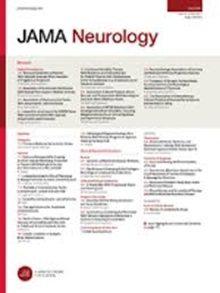Intracranial Hemorrhage in Patients With Stroke After Endovascular Treatment With or Without IV Alteplase: An Individual Participant Data Meta-Analysis.
IF 21.3
1区 医学
Q1 CLINICAL NEUROLOGY
引用次数: 0
Abstract
Importance For patients with acute ischemic stroke due to anterior circulation large vessel occlusion and presenting directly to endovascular treatment (EVT)-capable centers, intravenous thrombolysis (IVT) before EVT raises concerns about intracranial hemorrhage (ICH), but details are not well understood. Objective To determine the frequency and subtypes of ICH in patients treated with IVT plus EVT vs EVT alone and to determine the association between various ICH subtypes and patient functional outcomes. Data Sources PubMed and MEDLINE were searched from database inception through March 9, 2023. Study Selection Randomized clinical trials comparing EVT alone with IVT plus EVT for anterior circulation large vessel occlusion stroke were included. Data Extraction and Synthesis Individual participant data were extracted following the Preferred Reporting Items for Systematic Review and Meta-Analyses of independent participant data (PRISMA-IPD) reporting guidelines. Data were pooled using a random-effects model. Data were analyzed between April 2024 and February 2025. Main Outcomes and Measures The primary outcomes were ICH and its subtypes according to the Heidelberg Bleeding Classification (hemorrhagic infarction type 1 [HI1], hemorrhagic infarction type 2 [HI2], parenchymal hematoma type 1 [PH1], parenchymal hematoma type 2 [PH2], and others; symptomatic or asymptomatic ICH), which were evaluated using a mixed-model approach with multinomial or binary regression. Results The analysis involved 2313 participants (1160 allocated to the IVT plus EVT group vs 1153 to EVT alone; median [IQR] age, 71 [62-78] years; 1025 female participants [44%]) from 6 studies. Any ICH occurred in 768 of 2261 participants (34%). IVT was associated with an increased rate of any ICH (411 of 1133 [36%] vs 357 of 1128 [32%]; adjusted odds ratio [OR], 1.23; 95% CI, 1.02-1.49; P = .03) and a higher rate of any parenchymal hematoma (PH1 or PH2) (82 of 1133 [7%] vs 61 of 1128 [5%]; adjusted OR, 1.54; 95% CI, 1.02-2.34; P = .04). Compared with participants without ICH, asymptomatic ICH (adjusted common OR, 0.55; 95% CI, 0.46-0.65) and symptomatic ICH (adjusted common OR, 0.08; 95% CI, 0.05-0.13) were both associated with worse functional outcomes, and there was a graded association of ICH radiologic patterns and patient outcomes. Conclusions and Relevance In this individual participant data meta-analysis, compared with EVT alone, IVT plus EVT modestly increased the risk of ICH, notably any parenchymal hematoma. Although ICH was associated with worse functional outcomes, this effect may be offset by IVT's benefit in final successful reperfusion and early reperfusion.脑卒中患者在接受或不接受静脉注射阿替普酶血管内治疗后颅内出血:个体参与者数据荟萃分析
对于由于前循环大血管闭塞而直接出现在血管内治疗(EVT)中心的急性缺血性卒中患者,EVT前静脉溶栓(IVT)引起了对颅内出血(ICH)的担忧,但细节尚不清楚。目的比较静脉血栓栓塞加静脉血栓栓塞与单纯静脉血栓栓塞患者脑出血发生的频率和亚型,并探讨脑出血不同亚型与患者功能预后的关系。数据来源pubmed和MEDLINE从数据库建立到2023年3月9日。研究选择包括比较EVT单独与IVT加EVT治疗前循环大血管闭塞性卒中的随机临床试验。数据提取和综合:根据独立参与者数据系统评价和荟萃分析的首选报告项目(PRISMA-IPD)报告指南提取个体参与者数据。数据采用随机效应模型汇总。研究人员分析了2024年4月至2025年2月之间的数据。主要结局和指标:主要结局为脑出血及其根据海德堡出血分类的亚型(出血性梗死1型[HI1]、出血性梗死2型[HI2]、实质血肿1型[PH1]、实质血肿2型[PH2]等;有症状或无症状的脑出血),使用多项或二元回归的混合模型方法进行评估。分析涉及2313名参与者(IVT加EVT组1160名,单独EVT组1153名;中位[IQR]年龄为71岁[62-78]岁;来自6项研究的1025名女性参与者[44%])。2261名参与者中有768名(34%)发生脑出血。IVT与任何ICH发生率增加相关(1133例中有411例[36%]vs 1128例中有357例[32%];校正优势比[OR], 1.23;95% ci, 1.02-1.49;P = .03)和任何实质血肿(PH1或PH2)的发生率较高(1133例中有82例[7%]vs 1128例中有61例[5%];调整后OR为1.54;95% ci, 1.02-2.34;p = .04)。与没有脑出血的参与者相比,无症状脑出血(调整后的普通OR, 0.55;95% CI, 0.46-0.65)和症状性脑出血(校正普通OR, 0.08;95% CI, 0.05-0.13)均与较差的功能预后相关,并且脑出血放射学模式与患者预后有分级关联。结论和相关性在这项个体参与者数据荟萃分析中,与单独EVT相比,IVT加EVT适度增加脑出血的风险,特别是任何实质血肿。尽管脑出血与较差的功能预后相关,但这种影响可能被IVT在最终成功再灌注和早期再灌注中的益处所抵消。
本文章由计算机程序翻译,如有差异,请以英文原文为准。
求助全文
约1分钟内获得全文
求助全文
来源期刊

JAMA neurology
CLINICAL NEUROLOGY-
CiteScore
41.90
自引率
1.70%
发文量
250
期刊介绍:
JAMA Neurology is an international peer-reviewed journal for physicians caring for people with neurologic disorders and those interested in the structure and function of the normal and diseased nervous system. The Archives of Neurology & Psychiatry began publication in 1919 and, in 1959, became 2 separate journals: Archives of Neurology and Archives of General Psychiatry. In 2013, their names changed to JAMA Neurology and JAMA Psychiatry, respectively. JAMA Neurology is a member of the JAMA Network, a consortium of peer-reviewed, general medical and specialty publications.
 求助内容:
求助内容: 应助结果提醒方式:
应助结果提醒方式:


